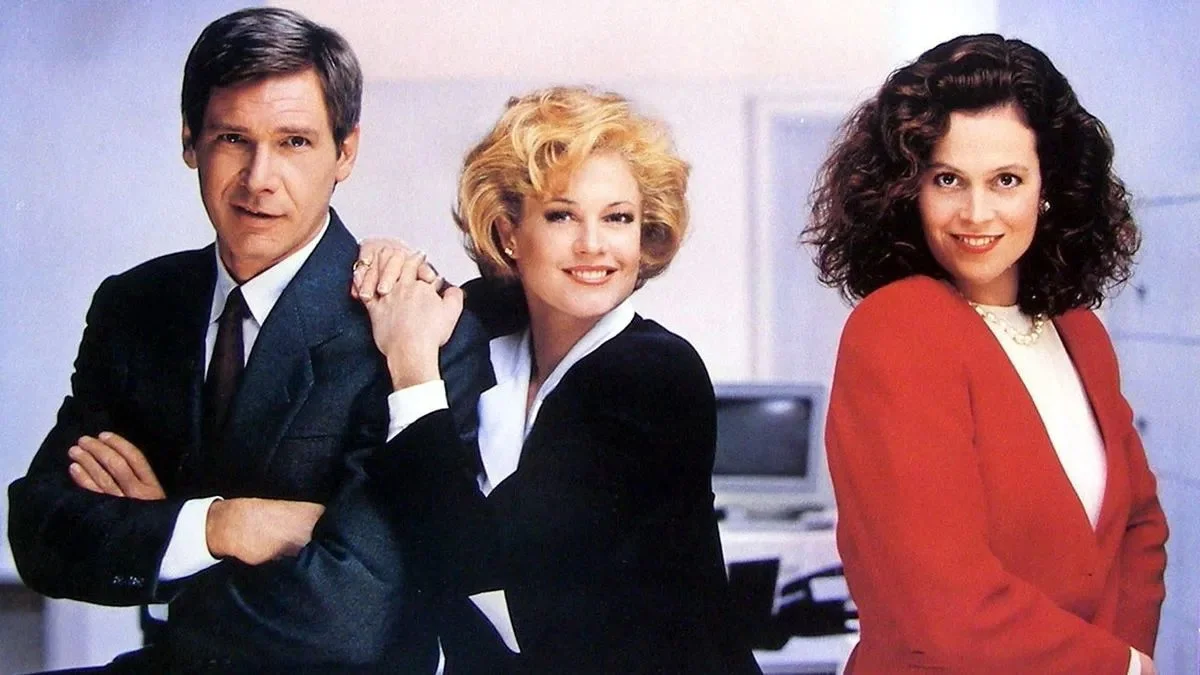Body Image in the Workplace: The Unspoken Rules for "Looking Professional"
from THE PROJECTION BOOTH website
One of my all-time favorite comedies is WORKING GIRL. Tess McGill, a girl from the wrong side of the river, fights her way up the Wall Street ladder through her conniving boss Katharine Parker and falls in love with a man who admires her brains and her moxie. Another masterclass in filmmaking by Mike Nichols. (Aside: if you are an artist/writer/filmmaker/playwright/creative, you must read Mike Nichols: A Life by Mark Harris. It’s a brilliant portrait of an artist’s need to create.)
The movie poster is iconic. It features three stars, all in their prime: Harrison Ford, our dreamboat hero Jack Trainer, stylishly dressed as a venture capitalist; Sigourney Weaver, the villain, looking gorgeous in a stunning red dress; and Melanie Griffith, our heroine Tess, dressed in a stylish women’s business suit, reflecting her new-found power. This picture so encompassed the look of the late 1980s. To get ahead, you were a Reaganite, Gordon Gekko, BABY BOOM professional dressed in fancy suits, shoulder pads, and pencil-thin skirts.
Here is what has always struck me about that imagery. Sigourney looks so much better. Her confidence exudes in the red dress. There is a scene where it’s a dumpling cocktail mixer, business suits as far as the eye can see. And here is Katharine Parker, a bright red star amidst the blandness. Her dress, and her attitude were a statement. I will be noticed. I will be stunning. I am not a minion. I am the queen.
She even has this brilliant line:
Dress shabbily, they notice the dress. Dress impeccably, they notice the woman - Coco Chanel.
Now I know Katharine is the villain, and she does some pretty awful things. (I’m not giving away any of the plot turns.) But let’s think about what Katharine and that scene represents. What does that dress say about the corporate world and “looking professional?”
I freely admit that I look horrible in blazers because I am a large woman with rounded shoulders. I don’t say this to insult myself. I am stating this objectively like the color puce does not blend with my skin tone, or a perm is a bad idea. (Perms are always a bad idea.) During the 1990s, I wore many business suits, and even today, I shudder when reminded of it. I tried variations on the corporate uniform, tweaking with cardigans or shawls. But all in all, I gave up and transitioned to stylish dresses that better accentuated by figure and made me feel more confident.
Years later, my fashion choices were put to the test. During my time at National Geographic, the PR team brought in a photographer to take headshots of key personnel, including me. I talked to my boss about the dress I wanted to wear for the shoot. I was told that PR mandated everyone wear a blazer because the higher-ups wanted uniformity. I tried to explain that a business suit was not ideal for my body type and could they make an exception. She was sympathetic but the answer was no.
I sucked it up, dug out a blazer and showed up for my session. And you know what? I looked awful. My shoulders were so broad, I could have had football pads on. Worst of all, any spark or confidence I had in my eye was gone.
Women outside of the “normal” size spectrum run into this all the time.
Covert biases are affirmed when professionals are forced to conform to a one-size-fits-all uniform.
Fat, short, very tall people and others look “sloppy,” “squatty,” or “ill-fitted.” I agree with many of these comments. Many of us do look bad. Why? Ready to wear business clothes are few and far between for those outside of a few clothes sizes. Sure, you can get clothes altered to fit you better. But that costs money and even then, not all fat, short, tall bodies are the same. Even finding a base pair of pants that fit well enough to alter are a chore. And blazers? Where do I start?
This anxiety over professional attire is part of a larger issue of workplace discrimination against fat people.
A study in 2010 indicated that “obese individuals are at higher risk of encountering stereotypes concerning their work-related qualities and for general unequal treatment in the work place.” Not only do the constant and valid concerns about people assuming one is lazy, unhealthy, or negligent weigh one down but doing so in a uniform that only highlights your differences…. it’s a lot. Now add being a woman. And a minority. The pressure is smothering.
All this brings me back to Katharine Parker in WORKING GIRL. Clothes should make you feel confident, proud, and reflect the power you possess. Artificial dress codes based on societal pressures of what looks “professional” puts a distinct disadvantage on those with a body type other than a coat rack.
Is one’s effectiveness diminished when wearing a dress? Or flats instead of heels?
One certainly does need to dress for the occasion. I should not wear my home office attire to a conference. But imposing uniformity when doing so diminishes the power and effectiveness of your employee is counterproductive and myopic.
Coco Chanel was right. Dress impeccably, they notice the person. Let the star shine.
###
About the Author:
Shannon Malone-Benedictis (she/her) is a two-time Emmy award-winning documentary filmmaker, creative consultant, speaker, and facilitator. From writing her first play at age 10 to executive producing documentaries for Disney+, Netflix, and others, she's always loved telling stories. Learn more about Shannon’s speaking topics and creative services at padlincreative.com.
#BodyPositivity
#InclusiveFashionWorkplace
#Plus-sizeProfessionalAttire
#DressingforPower
#WorkplaceEquality
#FatAcceptanceintheWorkPlace

